Portal:Myanmar
Portal maintenance status: (March 2022)
|
ကြိုဆိုပါတယ်။ / Welcome to the Myanmar Portal 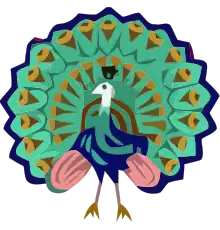

Myanmar (Burmese: မြန်မာ; MLCTS: mranma, pronounced [mjàɴmà]), officially the Republic of the Union of Myanmar, also known as Burma (the official name until 1989), is a country in Southeast Asia. It is the largest country by area in Mainland Southeast Asia and has a population of about 55 million. It is bordered by Bangladesh and India to its northwest, China to its northeast, Laos and Thailand to its east and southeast, and the Andaman Sea and the Bay of Bengal to its south and southwest. The country's capital city is Naypyidaw, and its largest city is Yangon (formerly Rangoon).
Myanmar is a member of the East Asia Summit, Non-Aligned Movement, ASEAN, and BIMSTEC, but it is not a member of the Commonwealth of Nations despite once being part of the British Empire. Myanmar is a Dialogue Partner of the Shanghai Cooperation Organization. The country is very rich in natural resources, such as jade, gems, oil, natural gas, teak and other minerals, as well as also endowed with renewable energy, having the highest solar power potential compared to other countries of the Great Mekong Subregion. However, Myanmar has long suffered from instability, factional violence, corruption, poor infrastructure, as well as a long history of colonial exploitation with little regard to human development. In 2013, its GDP (nominal) stood at US$56.7 billion and its GDP (PPP) at US$221.5 billion. The income gap in Myanmar is among the widest in the world, as a large proportion of the economy is controlled by cronies of the military junta. Myanmar is one of the least developed countries; as of 2020, according to the Human Development Index, it ranks 147 out of 189 countries in terms of human development, the lowest in Southeast Asia. Since 2021, more than 600,000 people were displaced across Myanmar due to the surge in violence post-coup, with more than 3 million people in dire need of humanitarian assistance. (Full article...)
Selected articles -
 Image 1
Image 1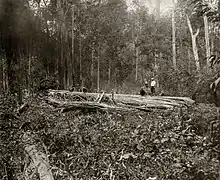 Black and white photograph of logging in Myanmar taken by a Bombay Burmah Trading Corporation official during British rule.
Black and white photograph of logging in Myanmar taken by a Bombay Burmah Trading Corporation official during British rule.
According to a report by the Food and Agriculture Organization of the United Nations, Myanmar (also known as Burma) lost 19%, or 7,445,000 hectares (28,750 sq mi), of forest between 1990 and 2010. With forest covering as much as 70% of Burma at the time of independence, there were only slightly more than 48% forest cover left as of 2014. The deforestation rate of Myanmar has declined from 0.95% per year in the years 1990–2010 to about 0.3% per year and deforestation in Myanmar is now less than other countries of the region such as Indonesia or Vietnam, but still remains an important environmental issue. Three main factors contribute to continued deforestation: unsustainable and illegal logging, unresolved land rights and land disputes and extensive agricultural development.
Myanmar possesses the largest expanse of tropical forest in mainland Southeast Asia with a biodiversity much greater than temperate forests. As of 2010, Burma's living forest biomass holds 1,654 million metric tons of carbon and is home to over 80 endemic species. Despite the diversity and size of Burma's forests, only 6.3% of the land is protected and much of it is under the threat of deforestation. (Full article...)![Image 2The Amyotha Hluttaw (Burmese: အမျိုးသားလွှတ်တော်, IPA: [ʔəmjóðá l̥ʊʔtɔ̀]; House of Nationalities) is the de jure upper house of the Pyidaungsu Hluttaw, the bicameral legislature of Myanmar (Burma). It consists of 224 members, of which 168 are directly elected and 56 appointed by the Myanmar Armed Forces. The last elections to the Amyotha Hluttaw were held in November 2015. At its second meeting on 3 February 2016, Mahn Win Khaing Than and Aye Thar Aung were elected Speaker and Deputy Speaker of the Amyotha Hluttaw and Speaker and Deputy Speaker of the Pyidaungsu Hluttaw as a whole.After the coup d'état on 1 February 2021, the Pyidaungsu Hluttaw was dissolved by Acting President Myint Swe, who declared a one-year state of emergency and transferred all legislative powers to Commander-in-Chief of Defence Services Min Aung Hlaing. (Full article...)](../I/Blank.png.webp) Image 2
Image 2
The Amyotha Hluttaw (Burmese: အမျိုးသားလွှတ်တော်, IPA: [ʔəmjóðá l̥ʊʔtɔ̀]; House of Nationalities) is the de jure upper house of the Pyidaungsu Hluttaw, the bicameral legislature of Myanmar (Burma). It consists of 224 members, of which 168 are directly elected and 56 appointed by the Myanmar Armed Forces. The last elections to the Amyotha Hluttaw were held in November 2015. At its second meeting on 3 February 2016, Mahn Win Khaing Than and Aye Thar Aung were elected Speaker and Deputy Speaker of the Amyotha Hluttaw and Speaker and Deputy Speaker of the Pyidaungsu Hluttaw as a whole.
After the coup d'état on 1 February 2021, the Pyidaungsu Hluttaw was dissolved by Acting President Myint Swe, who declared a one-year state of emergency and transferred all legislative powers to Commander-in-Chief of Defence Services Min Aung Hlaing. (Full article...) Image 3
Image 3 The Buddha giving a discourse on Māgha Pūjā
The Buddha giving a discourse on Māgha Pūjā
Myanmar (also written as Makha Bucha Day) is a Buddhist festival celebrated on the full moon day of the third lunar month in Cambodia, Laos, Thailand, Sri Lanka and on the full moon day of Tabaung in Myanmar. It is the second most important Buddhist festival after Vesak; it celebrates a gathering that was held between the Buddha and 1,250 of his first disciples, which, according to tradition, preceded the custom of periodic recitation of discipline by monks. On the day, Buddhists celebrate the creation of an ideal and exemplary community, which is why it is sometimes called Saṅgha Day, the Saṅgha referring to the Buddhist community, and for some Buddhist schools this is specifically the monastic community. In Thailand, the Pāli term Māgha-pūraṇamī is also used for the celebration, meaning 'to honor on the full moon of the third lunar month'. Finally, some authors referred to the day as the Buddhist All Saints Day.
In pre-modern times, Māgha Pūjā has been celebrated by some Southeast Asian communities. But it became widely popular in the modern period, when it was instituted in Thailand by King Rama IV in the mid-19th century. From Thailand, it spread to other South and Southeast Asian countries. Presently, it is a public holiday in some of these countries. It is an occasion when Buddhists go to the temple to perform merit-making activities, such as alms giving, meditation and listening to teachings. It has been proposed in Thailand as a more spiritual alternative to the celebration of Valentine's Day. (Full article...)![Image 4British forces launch an amphibious assault on Rangoon in May 1824.The First Anglo-Burmese War (Burmese: ပထမ အင်္ဂလိပ်-မြန်မာ စစ်; [pətʰəma̰ ɪ́ɰ̃ɡəleiʔ-mjəmà sɪʔ]; 5 March 1824 – 24 February 1826), also known as the First Burma War, was the first of three wars fought between the British and Burmese empires in the 19th century. The war, which began primarily over the control of what is now Northeastern India, ended in a decisive British victory, giving the British total control of Assam, Manipur, Cachar and Jaintia as well as Arakan Province and Tenasserim. The Burmese submitted to a British demand to pay an indemnity of one million pounds sterling, and signed a commercial treaty.The war was one of the most expensive in British Indian history. Fifteen thousand European and Indian soldiers died, together with an unknown number of Burmese military and civilian casualties. The high cost of the campaign to the British, 5–13 million pounds sterling (£400 million – £1.16 billion as of 2021) contributed to a severe economic crisis in British India which cost the East India Company its remaining privileges. (Full article...)](../I/Blank.png.webp) Image 4
Image 4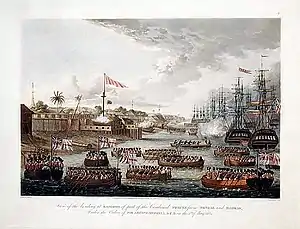 British forces launch an amphibious assault on Rangoon in May 1824.
British forces launch an amphibious assault on Rangoon in May 1824.
The First Anglo-Burmese War (Burmese: ပထမ အင်္ဂလိပ်-မြန်မာ စစ်; [pətʰəma̰ ɪ́ɰ̃ɡəleiʔ-mjəmà sɪʔ]; 5 March 1824 – 24 February 1826), also known as the First Burma War, was the first of three wars fought between the British and Burmese empires in the 19th century. The war, which began primarily over the control of what is now Northeastern India, ended in a decisive British victory, giving the British total control of Assam, Manipur, Cachar and Jaintia as well as Arakan Province and Tenasserim. The Burmese submitted to a British demand to pay an indemnity of one million pounds sterling, and signed a commercial treaty.
The war was one of the most expensive in British Indian history. Fifteen thousand European and Indian soldiers died, together with an unknown number of Burmese military and civilian casualties. The high cost of the campaign to the British, 5–13 million pounds sterling (£400 million – £1.16 billion as of 2021) contributed to a severe economic crisis in British India which cost the East India Company its remaining privileges. (Full article...) Image 5Burmese Days is the first novel by English writer George Orwell, published in 1934. Set in British Burma during the waning days of empire, when Burma was ruled from Delhi as part of British India, the novel serves as "a portrait of the dark side of the British Raj." At the centre of the novel is John Flory, "the lone and lacking individual trapped within a bigger system that is undermining the better side of human nature." The novel describes "both indigenous corruption and imperial bigotry" in a society where, "after all, natives were natives—interesting, no doubt, but finally...an inferior people".
Image 5Burmese Days is the first novel by English writer George Orwell, published in 1934. Set in British Burma during the waning days of empire, when Burma was ruled from Delhi as part of British India, the novel serves as "a portrait of the dark side of the British Raj." At the centre of the novel is John Flory, "the lone and lacking individual trapped within a bigger system that is undermining the better side of human nature." The novel describes "both indigenous corruption and imperial bigotry" in a society where, "after all, natives were natives—interesting, no doubt, but finally...an inferior people".
Burmese Days was first published "further afield," in the United States, because of concerns that it might be potentially libelous; that the real provincial town of Katha had been described too realistically; and that some of its fictional characters were based too closely on identifiable people. A British edition, with altered names, appeared a year later. Nonetheless, Orwell's harsh portrayal of colonial society was felt by "some old Burma hands" to have "rather let the side down". In a letter from 1946, Orwell wrote, "I dare say it's unfair in some ways and inaccurate in some details, but much of it is simply reporting what I have seen". (Full article...) Image 6The prehistory of Burma (Myanmar) spanned hundreds of millennia to about 200 BCE. Archaeological evidence shows that the Homo erectus had lived in the region now known as Burma as early as 750,000 years ago, and the Homo sapiens about 11,000 BCE, in a Stone Age culture called the Anyathian. Named after the central dry zone sites where most of the early settlement finds are located, the Anyathian period was when plants and animals were first domesticated and polished stone tools appeared in Burma. Though these sites are situated in fertile areas, evidence shows these early people were not yet familiar with agricultural methods.
Image 6The prehistory of Burma (Myanmar) spanned hundreds of millennia to about 200 BCE. Archaeological evidence shows that the Homo erectus had lived in the region now known as Burma as early as 750,000 years ago, and the Homo sapiens about 11,000 BCE, in a Stone Age culture called the Anyathian. Named after the central dry zone sites where most of the early settlement finds are located, the Anyathian period was when plants and animals were first domesticated and polished stone tools appeared in Burma. Though these sites are situated in fertile areas, evidence shows these early people were not yet familiar with agricultural methods.
The Bronze Age arrived c. 1500 BCE when people in the region were turning copper into bronze, growing rice, and domesticating chickens and pigs. The Iron Age arrived around 500 BCE when iron-working settlements emerged in an area south of present-day Mandalay. Evidence also shows rice growing settlements of large villages and small cities that traded with their surroundings and as far as China between 500 BCE and 200 CE. Bronze-decorated coffins and burial sites filled with the earthenware remains of feasting and drinking provide a glimpse of the lifestyle of their affluent society. (Full article...)![Image 7Zarganar speaking at the Freedom Film Festival in Yangon, Myanmar on 1 January 2012.Maung Thura "Zarganar" (also called Zaganar, Burmese: ဇာဂနာ; also Zargana, pronounced [zàɡənà]); born 27 January 1961) is a popular Burmese comedian, film actor, and a film director as well as a fierce critic and often political prisoner of the Burmese military government. Known for his wicked puns against the government which is a military junta, Zarganar, whose name translates to "tweezers", is widely considered to be the most popular comedian and satirist in Myanmar.In September 2006, Zarganar was banned indefinitely from performing publicly or participating in any kind of entertainment related work. He was arrested on 4 June 2008 for speaking to foreign media about the situation of millions of people left homeless after a cyclone devastated the Irrawaddy Delta. In November 2008, he was sentenced to 59 years in prison, convicted of "public order offenses", under four sections of the criminal code—17/2, 32 (b), 295 (a) and 505 (b), much more than the anticipated maximum of two years. On 16 February 2009, following the appeals by the family, Yangon Divisional Court reduced the prison sentence by "up to 24 years", bringing the sentence down to 35 years. In December 2008, Zarganar has been sent to Myitkyina Prison in Kachin State in the country's far north, from which he was freed on 11 October 2011 in a mass amnesty of political prisoners. (Full article...)](../I/Blank.png.webp) Image 7
Image 7 Zarganar speaking at the Freedom Film Festival in Yangon, Myanmar on 1 January 2012.
Zarganar speaking at the Freedom Film Festival in Yangon, Myanmar on 1 January 2012.
Maung Thura "Zarganar" (also called Zaganar, Burmese: ဇာဂနာ; also Zargana, pronounced [zàɡənà]); born 27 January 1961) is a popular Burmese comedian, film actor, and a film director as well as a fierce critic and often political prisoner of the Burmese military government. Known for his wicked puns against the government which is a military junta, Zarganar, whose name translates to "tweezers", is widely considered to be the most popular comedian and satirist in Myanmar.
In September 2006, Zarganar was banned indefinitely from performing publicly or participating in any kind of entertainment related work. He was arrested on 4 June 2008 for speaking to foreign media about the situation of millions of people left homeless after a cyclone devastated the Irrawaddy Delta. In November 2008, he was sentenced to 59 years in prison, convicted of "public order offenses", under four sections of the criminal code—17/2, 32 (b), 295 (a) and 505 (b), much more than the anticipated maximum of two years. On 16 February 2009, following the appeals by the family, Yangon Divisional Court reduced the prison sentence by "up to 24 years", bringing the sentence down to 35 years. In December 2008, Zarganar has been sent to Myitkyina Prison in Kachin State in the country's far north, from which he was freed on 11 October 2011 in a mass amnesty of political prisoners. (Full article...) Image 8The 2010–2012 Myanmar border clashes were a series of skirmishes between the Tatmadaw (Myanmar Armed Forces) on one side, and the DKBA-5 and the Karen National Liberation Army (KNLA) on the other. The clashes erupted along the border with Thailand shortly after Myanmar's general election on 7 November 2010. An estimated 10,000 refugees have fled into nearby neighbouring Thailand to escape the violent conflict. There was concern that due to discontent with the elections, and speculations of electoral fraud, that the conflict could escalate into a civil war. (Full article...)
Image 8The 2010–2012 Myanmar border clashes were a series of skirmishes between the Tatmadaw (Myanmar Armed Forces) on one side, and the DKBA-5 and the Karen National Liberation Army (KNLA) on the other. The clashes erupted along the border with Thailand shortly after Myanmar's general election on 7 November 2010. An estimated 10,000 refugees have fled into nearby neighbouring Thailand to escape the violent conflict. There was concern that due to discontent with the elections, and speculations of electoral fraud, that the conflict could escalate into a civil war. (Full article...)![Image 9Shan State (Shan: မိူင်းတႆး, Möng Tai; Burmese: သျှမ်းပြည်နယ်, pronounced [ʃáɰ̃ pjìnɛ̀]) is a state of Myanmar. Shan State borders China (Yunnan) to the north, Laos (Louang Namtha and Bokeo Provinces) to the east, and Thailand (Chiang Rai, Chiang Mai and Mae Hong Son Provinces) to the south, and five administrative divisions of Burma (Myanmar) in the west. The largest of the 14 administrative divisions by land area, Shan State covers 155,800 km2, almost a quarter of the total area of Myanmar. The state gets its name from Burmese name for the Tai peoples: "Shan people". The Tai (Shan) constitute the majority among several ethnic groups that inhabit the area. Shanland is largely rural, with only three cities of significant size: Lashio, Kengtung, and the capital, Taunggyi. Taunggyi is 150.7 km northeast of the nation's capital Naypyitaw.The Shan state, with many ethnic groups, is home to several armed ethnic armies. While the military government has signed ceasefire agreements with most groups, vast areas of the state, especially those east of the Salween River, remain outside the central government's control, and in recent years have come under heavy ethnic-Han Chinese economic and political influence. Other areas are under the control of military groups such as the Shan State Army. (Full article...)](../I/Blank.png.webp) Image 9
Image 9
Shan State (Shan: မိူင်းတႆး, Möng Tai; Burmese: သျှမ်းပြည်နယ်, pronounced [ʃáɰ̃ pjìnɛ̀]) is a state of Myanmar. Shan State borders China (Yunnan) to the north, Laos (Louang Namtha and Bokeo Provinces) to the east, and Thailand (Chiang Rai, Chiang Mai and Mae Hong Son Provinces) to the south, and five administrative divisions of Burma (Myanmar) in the west. The largest of the 14 administrative divisions by land area, Shan State covers 155,800 km2, almost a quarter of the total area of Myanmar. The state gets its name from Burmese name for the Tai peoples: "Shan people". The Tai (Shan) constitute the majority among several ethnic groups that inhabit the area. Shanland is largely rural, with only three cities of significant size: Lashio, Kengtung, and the capital, Taunggyi. Taunggyi is 150.7 km northeast of the nation's capital Naypyitaw.
The Shan state, with many ethnic groups, is home to several armed ethnic armies. While the military government has signed ceasefire agreements with most groups, vast areas of the state, especially those east of the Salween River, remain outside the central government's control, and in recent years have come under heavy ethnic-Han Chinese economic and political influence. Other areas are under the control of military groups such as the Shan State Army. (Full article...) Image 10
Image 10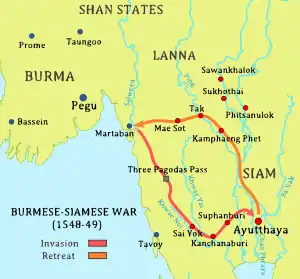 Map of the 1548–1549 campaign
Map of the 1548–1549 campaign
The Burmese–Siamese War (1547–1549) (Burmese: ယိုးဒယား-မြန်မာစစ် (၁၅၄၇–၄၉); Thai: สงครามพม่า-สยาม พ.ศ. 2090–2092), also known as the Shwehti war (Thai: สงครามพระเจ้าตะเบ็งชเวตี้) was the first war fought between the Toungoo dynasty of Burma and the Ayutthaya Kingdom of Siam, and the first of the Burmese–Siamese wars that would continue until the middle of the 19th century. The war is notable for the introduction of early modern warfare to the region. It is also notable in Thai history for the death in battle of Siamese Queen Suriyothai on her war elephant; the conflict is often referred to in Thailand as the War that Led to the Loss of Queen Suriyothai (สงครามคราวเสียสมเด็จพระสุริโยไท).
The casus belli have been stated as a Burmese attempt to expand their territory eastwards after a political crisis in Ayutthaya as well as an attempt to stop Siamese incursions into the upper Tenasserim coast. The war, according to the Burmese, began in January 1547 when Siamese forces conquered the frontier town of Tavoy (Dawei). Later in the year, the Burmese forces led by Gen. Saw Lagun Ein retook the Upper Tenasserim coast down to Tavoy. Next year, in October 1548, three Burmese armies led by King Tabinshwehti and his deputy Bayinnaung invaded Siam through the Three Pagodas Pass. The Burmese forces penetrated up to the capital city of Ayutthaya but could not take the heavily fortified city. One month into the siege, Siamese counterattacks broke the siege, and drove back the invasion force. But the Burmese negotiated a safe retreat in exchange for the return of two important Siamese nobles (the heir apparent Prince Ramesuan, and Prince Thammaracha of Phitsanulok) whom they had captured. (Full article...)
Did you know (auto-generated) -
- ... that Maw Htun Aung, a Shan Nationalities League for Democracy candidate in the 2020 Myanmar general election, is Kachin, not Shan?
- ... that the talabaw soup, which consists primarily of bamboo shoots, is the essential dish of Myanmar's Karen people, who use it to supplement rice?
- ... that the Burmese and South Korean first ladies held their first informal conversation 44 years after the establishment of bilateral relations between the two countries?
- ... that squatters in Myanmar were punished for protesting against the 2021 coup d'état by being evicted?
- ... that while defending Zaw Myint Maung following his arrest by the Myanmar junta, lawyer Ywet Nu Aung was herself arrested and charged?
- ... that Rolling Stone named Mission of Burma's "Academy Fight Song" as one of the 100 greatest debut singles of all time?
- ... that the creator of a video depicting the 2021 Myanmar coup d'état, which featured Indonesian politically satirical song "Ampun Bang Jago", denied that it was politically motivated?
- ... that Rangoon kept its own time for more than two decades after Burma Standard Time first came into effect?
Related portals and projects
Southeast Asia
Other Countries
![]() WikiProject Myanmar
WikiProject Myanmar
![]() WikiProject Southeast Asia
WikiProject Southeast Asia
![]() WikiProject Asia
WikiProject Asia
General images -
_headquarter.jpg.webp) Image 1Aung San Suu Kyi addresses crowds at the NLD headquarters shortly after her release. (from History of Myanmar)
Image 1Aung San Suu Kyi addresses crowds at the NLD headquarters shortly after her release. (from History of Myanmar).jpg.webp) Image 2Salween river at Mae Sam Laep on the Thai-Myanmar border (from Geography of Myanmar)
Image 2Salween river at Mae Sam Laep on the Thai-Myanmar border (from Geography of Myanmar)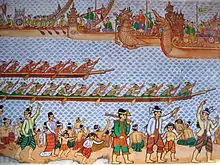 Image 3Hlei pyaingbwè - a Burmese regatta (from Culture of Myanmar)
Image 3Hlei pyaingbwè - a Burmese regatta (from Culture of Myanmar)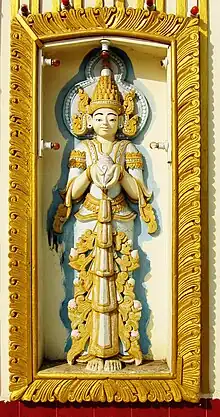
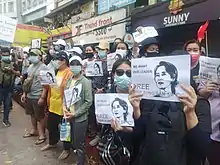 Image 5Protesters in Yangon carrying signs reading "Free Daw Aung San Suu Kyi" on 8 February 2021. (from History of Myanmar)
Image 5Protesters in Yangon carrying signs reading "Free Daw Aung San Suu Kyi" on 8 February 2021. (from History of Myanmar)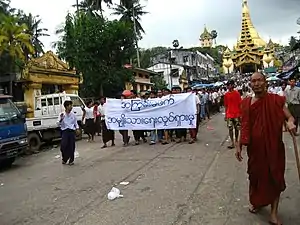 Image 6Protesters in Yangon with a banner that reads non-violence: national movement in Burmese, in the background is Shwedagon Pagoda. (from History of Myanmar)
Image 6Protesters in Yangon with a banner that reads non-violence: national movement in Burmese, in the background is Shwedagon Pagoda. (from History of Myanmar)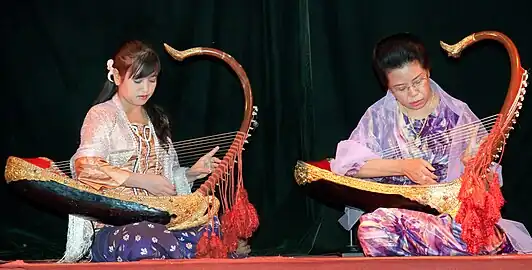 Image 7Two female musicians play the saung at a performance in Mandalay. (from Culture of Myanmar)
Image 7Two female musicians play the saung at a performance in Mandalay. (from Culture of Myanmar)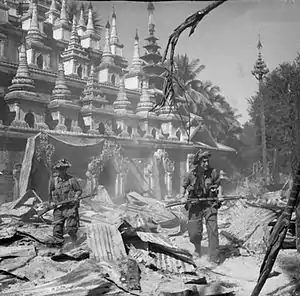 Image 8British soldiers on patrol in the ruins of the Burmese town of Bahe during the advance on Mandalay, January 1945. (from History of Myanmar)
Image 8British soldiers on patrol in the ruins of the Burmese town of Bahe during the advance on Mandalay, January 1945. (from History of Myanmar) Image 9Former US President Barack Obama poses barefoot on the grounds of Shwedagon Pagoda, one of Myanmar's major Buddhist pilgrimage sites. (from Culture of Myanmar)
Image 9Former US President Barack Obama poses barefoot on the grounds of Shwedagon Pagoda, one of Myanmar's major Buddhist pilgrimage sites. (from Culture of Myanmar) Image 10The shores of Irrawaddy River at Nyaung-U, Bagan (from Geography of Myanmar)
Image 10The shores of Irrawaddy River at Nyaung-U, Bagan (from Geography of Myanmar)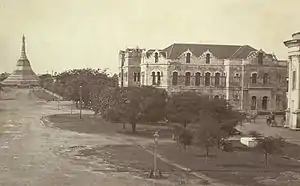 Image 11Recorder's Court on Sule Pagoda Road, with the Sule Pagoda at the far end, Rangoon, 1868. Photographer: J. Jackson. (from History of Myanmar)
Image 11Recorder's Court on Sule Pagoda Road, with the Sule Pagoda at the far end, Rangoon, 1868. Photographer: J. Jackson. (from History of Myanmar)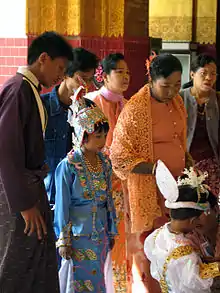
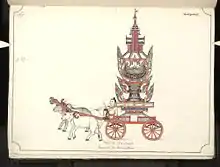 Image 1319th century funeral cart and spire, which would form part of the procession from the home to the place of cremation (from Culture of Myanmar)
Image 1319th century funeral cart and spire, which would form part of the procession from the home to the place of cremation (from Culture of Myanmar)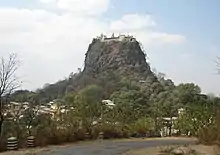
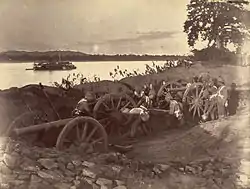 Image 15British soldiers dismantling cannons belonging to King Thibaw's forces, Third Anglo-Burmese War, Ava, 27 November 1885. Photographer: Hooper, Willoughby Wallace (1837–1912). (from History of Myanmar)
Image 15British soldiers dismantling cannons belonging to King Thibaw's forces, Third Anglo-Burmese War, Ava, 27 November 1885. Photographer: Hooper, Willoughby Wallace (1837–1912). (from History of Myanmar)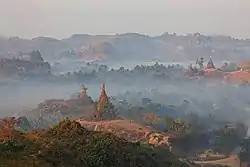 Image 16Temples at Mrauk U, was the capital of the Mrauk U Kingdom, which ruled over what is now Rakhine State. (from History of Myanmar)
Image 16Temples at Mrauk U, was the capital of the Mrauk U Kingdom, which ruled over what is now Rakhine State. (from History of Myanmar)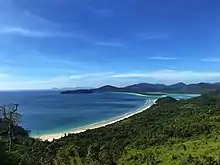 Image 17Grandfather Island, Dawei (from Geography of Myanmar)
Image 17Grandfather Island, Dawei (from Geography of Myanmar)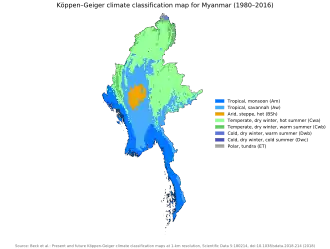 Image 18Myanmar (Burma) map of Köppen climate classification (from Geography of Myanmar)
Image 18Myanmar (Burma) map of Köppen climate classification (from Geography of Myanmar)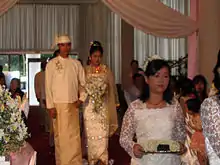 Image 19A wedding procession, with the groom and bride dressed in traditional Burmese wedding clothes, reminiscent of royal attire. (from Culture of Myanmar)
Image 19A wedding procession, with the groom and bride dressed in traditional Burmese wedding clothes, reminiscent of royal attire. (from Culture of Myanmar)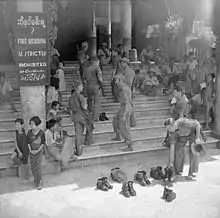 Image 20British soldiers remove their shoes at the entrance of Shwedagon Pagoda. To the left, a sign reads "Foot wearing is strictly prohibited" in Burmese, English, Tamil, and Urdu. (from Culture of Myanmar)
Image 20British soldiers remove their shoes at the entrance of Shwedagon Pagoda. To the left, a sign reads "Foot wearing is strictly prohibited" in Burmese, English, Tamil, and Urdu. (from Culture of Myanmar)
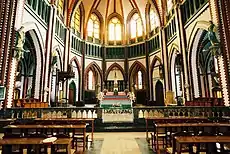 Image 22Saint Mary's Cathedral in Downtown Yangon is the largest Roman Catholic cathedral in Burma. (from Culture of Myanmar)
Image 22Saint Mary's Cathedral in Downtown Yangon is the largest Roman Catholic cathedral in Burma. (from Culture of Myanmar)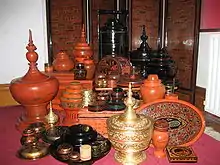
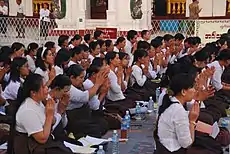 Image 24A group of Buddhist worshipers at Shwedagon Pagoda, an important religious site for Burmese Buddhists. (from Culture of Myanmar)
Image 24A group of Buddhist worshipers at Shwedagon Pagoda, an important religious site for Burmese Buddhists. (from Culture of Myanmar)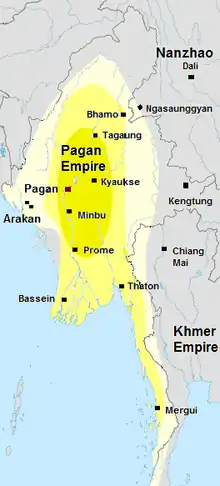 Image 25Pagan Kingdom during Narapatisithu's reign. Burmese chronicles also claim Kengtung and Chiang Mai. Core areas shown in darker yellow. Peripheral areas in light yellow. Pagan incorporated key ports of Lower Burma into its core administration by the 13th century. (from History of Myanmar)
Image 25Pagan Kingdom during Narapatisithu's reign. Burmese chronicles also claim Kengtung and Chiang Mai. Core areas shown in darker yellow. Peripheral areas in light yellow. Pagan incorporated key ports of Lower Burma into its core administration by the 13th century. (from History of Myanmar)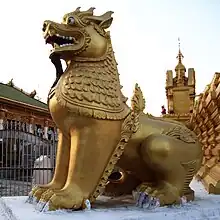 Image 26Sculpture of Myanmar mythical lion (from Culture of Myanmar)
Image 26Sculpture of Myanmar mythical lion (from Culture of Myanmar)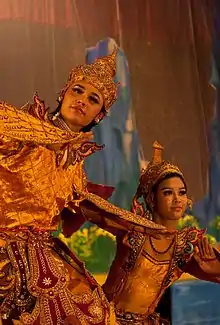 Image 27A theatrical performance of the Mon dance (from Culture of Myanmar)
Image 27A theatrical performance of the Mon dance (from Culture of Myanmar)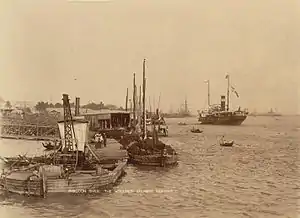 Image 28The paddle steamer Ramapoora (right) of the British India Steam Navigation Company on the Rangoon river having just arrived from Moulmein. 1895. Photographers: Watts and Skeen (from History of Myanmar)
Image 28The paddle steamer Ramapoora (right) of the British India Steam Navigation Company on the Rangoon river having just arrived from Moulmein. 1895. Photographers: Watts and Skeen (from History of Myanmar)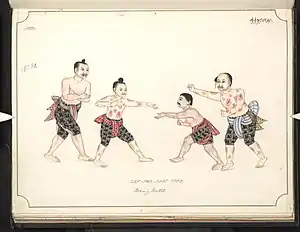 Image 29Boxing match. 19th-century watercolour (from Culture of Myanmar)
Image 29Boxing match. 19th-century watercolour (from Culture of Myanmar)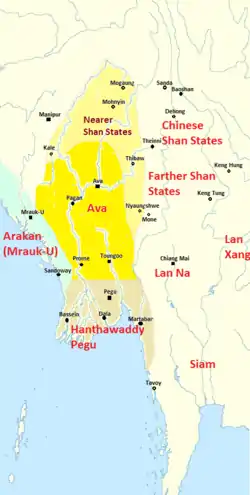 Image 30Political Map of Burma (Myanmar) c. 1450 CE. (from History of Myanmar)
Image 30Political Map of Burma (Myanmar) c. 1450 CE. (from History of Myanmar)
 Image 32Aerial view of a burned Rohingya village in Rakhine state, Myanmar, September 2017 (from History of Myanmar)
Image 32Aerial view of a burned Rohingya village in Rakhine state, Myanmar, September 2017 (from History of Myanmar)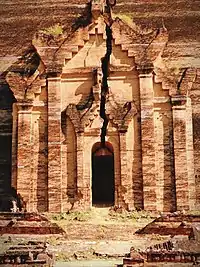 Image 33A large fracture on the Mingun Pahtodawgyi caused by the 1839 Ava earthquake. (from Geography of Myanmar)
Image 33A large fracture on the Mingun Pahtodawgyi caused by the 1839 Ava earthquake. (from Geography of Myanmar)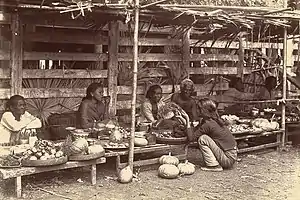 Image 34Vegetable stall on the roadside at the Madras Lancer Lines, Mandalay, January 1886. Photographer: Hooper, Willoughby Wallace (1837–1912). (from History of Myanmar)
Image 34Vegetable stall on the roadside at the Madras Lancer Lines, Mandalay, January 1886. Photographer: Hooper, Willoughby Wallace (1837–1912). (from History of Myanmar)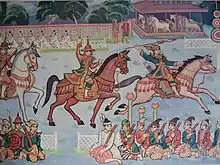 Image 35Myinhkin thabin - equestrian sport (from Culture of Myanmar)
Image 35Myinhkin thabin - equestrian sport (from Culture of Myanmar)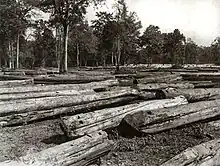
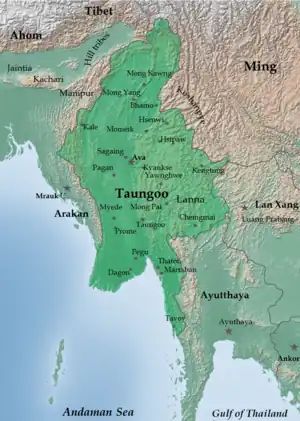 Image 37The restored Taungoo or Nyaungyan dynasty c. 1650 CE. (from History of Myanmar)
Image 37The restored Taungoo or Nyaungyan dynasty c. 1650 CE. (from History of Myanmar)
 Image 39A bull fight. 19th-century watercolour (from Culture of Myanmar)
Image 39A bull fight. 19th-century watercolour (from Culture of Myanmar)
Major topics
Categories
More topics
|
| |||||||||||||||||||||||||||||||||||||||||||||||||||||||||||||||||||||||||||||||||||||||||||||||||||||||||||||||||||||||||||||||||||||||||||||||||||||||||||||||||||||||||||||||||||||||||||||||||||||||||||||||||||||||||||
Associated Wikimedia
The following Wikimedia Foundation sister projects provide more on this subject:
-
 Commons
Commons
Free media repository -
 Wikibooks
Wikibooks
Free textbooks and manuals -
 Wikidata
Wikidata
Free knowledge base -
 Wikinews
Wikinews
Free-content news -
 Wikiquote
Wikiquote
Collection of quotations -
 Wikisource
Wikisource
Free-content library -
 Wikiversity
Wikiversity
Free learning tools -
 Wikivoyage
Wikivoyage
Free travel guide -
 Wiktionary
Wiktionary
Dictionary and thesaurus
More portals
-
 List of all portalsList of all portals
List of all portalsList of all portals -
 The arts portal
The arts portal -
 Biography portal
Biography portal -
 Current events portal
Current events portal -
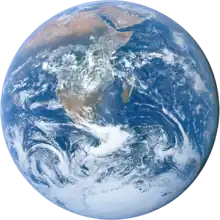 Geography portal
Geography portal -
 History portal
History portal -
 Mathematics portal
Mathematics portal -
 Science portal
Science portal -
 Society portal
Society portal -
 Technology portal
Technology portal -
 Random portalRandom portal
Random portalRandom portal -
 WikiProject PortalsWikiProject Portals
WikiProject PortalsWikiProject Portals